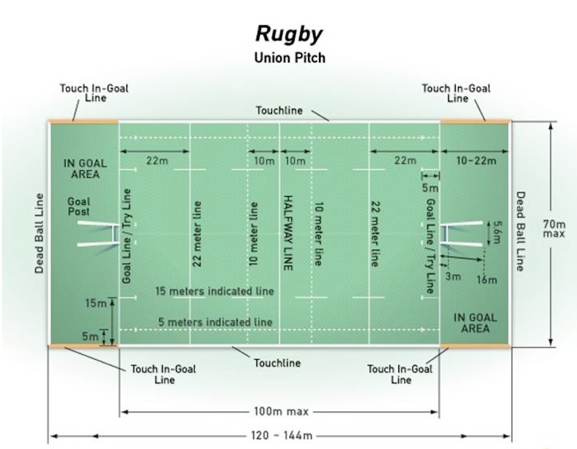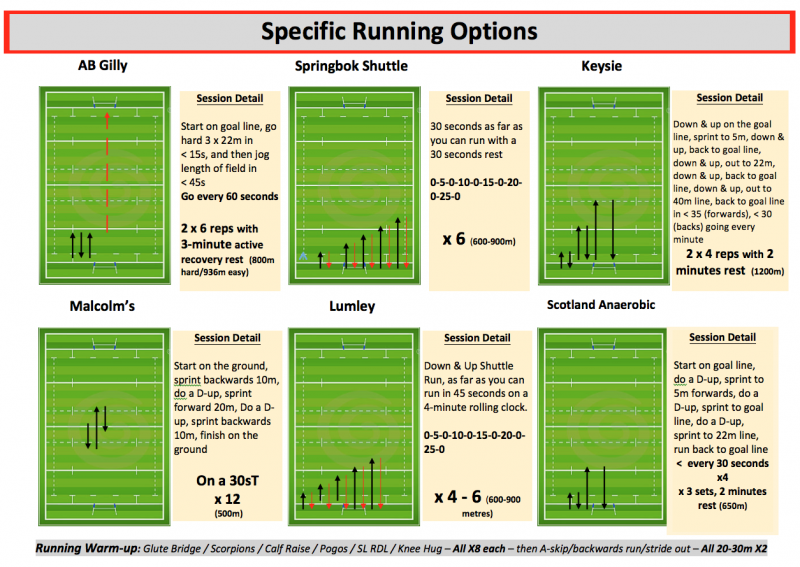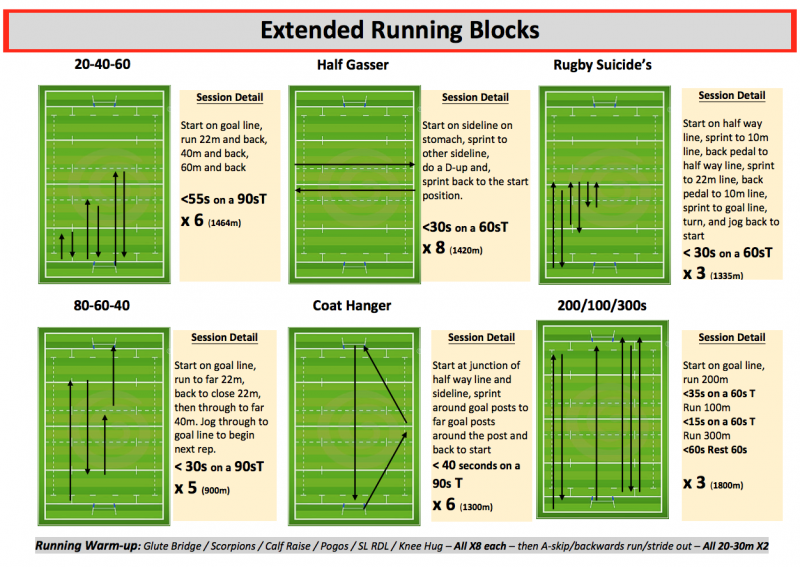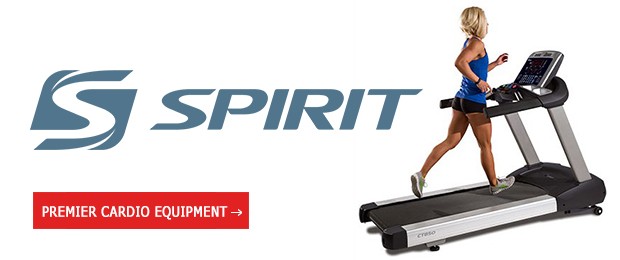
When I first went to work at the Paramatta Eels rugby league team in 1997, Head Coach Smith said something to me that has resonated through the years and formed a huge part of my personal philosophy within the strength and conditioning industry. He said, "This is the coaching pot, filled will all my years of experience. You can take what you need but you must put all your experience ideas in as well so others can benefit from it." It is such a shame that I have not seen this in action in many other programs since. So, this compilation of training sessions is drawn from many people’s ideas. Some I have listed. To others, I apologize, but I do not remember where I received them. As Dave Tate has always said, "Live, Learn, Pass On."
The intensity of each session will vary depending on the specific fitness levels of the groups and individuals that you are working with, hence the necessity of testing in the initial training week and periodically throughout the training block to ensure that intensities and distances per session are challenging the metabolic systems of the athletes. I use the standard 2.4-kilometer time trial on a track, if possible, as my first day back test, since it requires players to go hard from the get-go to ensure a good time. The fitter they are, the better the time.
The YoYo recovery shuttle run test is also an excellent test, but I now want to wait a couple of weeks before using this, as players just coming off a break have not conditioned the groins to change-of-direction work, and hence if done immediately upon return, may place undue stress on de-conditioned muscles, ligaments, and tendons. Other tests such as the 20-40-60 continuous shuttle run, 30-second springbok shuttle, and other directional change tests can be programmed after initial conditioning as well.
Treadmill
Treadmill Grade (1% to 2%)/Spin Bike Recoveries — If no spin bike, reduce the intensity and slow jog or walk for recoveries. Set speeds so that you are constantly challenged to make the time. Listed speeds are just a suggestion.
- Workout A – 3 x 5 minutes at 10 kilometers/hour, 2.5 minutes spin
- Workout B – 5 x 3 minutes at 12 kilometers/hour, 1.5 minutes spin
- Workout C – 15 x 1 minute at 14 kilometers/hour, 1 minute spin
Weapon 1 — Short Intervals x 10
- 3 minutes at 10 kilometers/hour, 1 minute spin
- 1 minute at 14 kilometers/hour, 1 minute spin
- 30 seconds at 18 kilometers/hour, 1 minute spin
Weapon 2 — Ladder
Repeat back up the ladder one through five.
- 5 minutes at 11 kilometers/hour, 2.5 minutes spin
- 4 minutes at 12 kilometers/hour, 2 minutes spin
- 3 minutes at 13 kilometers/hour, 1.5 minutes spin
- 2 minutes at 14 kilometers/hour, 1 minute spin
- 1 minute at 15 kilometers/hour, 30 seconds spin
Weapon 3 – Long to Short Intervals
- 5 minutes at 11 kilometers/hour, 2.5 minutes spin
- 4 minutes at 12 kilometers/hour, 2 minutes spin
- 3 minutes at 13 kilometers/hour, 1.5 minutes spin
- 2 minutes at 14 kilometers/hour, 1 minute spin
- 1 minute at 16 kilometers/hour, 1 minute spin
- 30 seconds at 18 kilometers/hour, 1 minute spin
- 15 seconds at 20 kilometers/hour
Weapon 4 — Short Ladder
Repeat in reverse direction.
- 5 minutes at 12 kilometers/hour, 2.5 minutes spin
- 3 minutes at 14 kilometers/hour, 1.5 minutes spin
- 1 minute at 16 kilometers/hour, 1 minute spin
Weapon 5 – 40/20 Session
No spin bike, just hop (10-15) to the sides of the treadmill.
- 5 minutes at 10 kilometers/hour
- 40 seconds at 16 kilometers/hour
- 20 seconds rest
- 20 seconds at 20 kilometers/hour
- 40 seconds rest
Rowing or Ski Erg Sessions
Weapon 1: 500-Meter Intervals
- 1:42 target time each rep
- 10 reps
- 2 minutes recovery between reps
Weapon 2: Varied Length Intervals
- 6 x 500-meter intervals (1:35 target time per interval)
- 4 x 250-meter intervals (0:55 target time per interval)
An additional target is to maintain a drop off of less than 10 seconds for both 500-meter and 250-meter intervals.
Weapon 3: Ladder
Intervals of 50 meters up to 500 meters, increasing 50 meters per interval and back down. Use maximal pace throughout. Use one-to-one recovery time each rep.
Weapon 4: Decrement
- 3 x 1000 meters; target times under 3:15, 3:20, 3:30
- 3 x 500 meters; target time under 1:40
- 1:1 recovery for all reps
Weapon 5:
Set 1
- 3-minute row at sub 1:40/500 meters pace
- 30 seconds rest
- 3-minute row at sub 1:45/500 meters pace
- 60 seconds rest
- 3-minute row at sub 1:48/500 meters pace
- 60 seconds rest
- 3-minute row at sub 1:50/500 meters pace
- 60 seconds rest
Set 2
- 10 x 30-second row at sub 1:35/500 meters pace
- 30 seconds rest between reps
Set 3
- 20 x 10-second row at sub 1:30/500 meters pace
- 10-second rest between reps
Weapon 6
Pick one of:
- 3 x 2000 meters (3 minutes recovery between reps)
- 5 sets of 4 x 250 meters in less than one minute, with 30 seconds rest between reps and two minutes rest between sets
Weapon 7
- 10 x 300 meters in less than one minute
- One minute rest between sets
Watt Bike or Computer Bike or Spin Bike Sessions
- Spin fast for 1, 2, 3, 4, 5 minutes with 30 seconds slow turnover between each. Three total sets.
- Spin fast one minute, out-of-seat climb one minute, then 2/2, 3/3, 4/4, 5/5, then down the ladder five to one.
- 45-second fast, 15-second slow x 15; 30-second fast, 30-second slow x 15; 45-second fast, 15-second slow x 15
- Continuous for 45 minutes with an out-of-seat 15 seconds every minute.
WB 1 — 15,000 Meters
15 x 1,000 meters as fast as you can on a two-minute rolling clock.
WB 2 — 5, 4, 3, 2, 1
5,000 meters, 4,000 meters, 3,000 meters, 2,000 meters, 1,000 meters with one on, one off recovery.
WB 3 — One On, One Off
Ride as far as possible in one minute then repeat after one minute rest for 15 sets.
WB 4 — Speed
- 5 x 200 meters with 90 seconds recovery between sets
- 10 x 100 meters with 60 seconds recovery between sets
- 15 x 50 meters with 30 seconds recovery between sets
WB 5 — The Beast
Six sprints, six times through:
- Sprint 10 seconds, active rest 10 seconds
- Sprint 20 seconds, active rest 20 seconds
- Sprint 30 seconds, active rest 30 seconds
- Sprint 40 seconds, active rest 40 seconds
- Sprint 50 seconds, active rest 50 seconds
- Sprint 60 seconds, active rest 60 seconds
WB 6 — Lactate Heaven
45 seconds as fast as you can. The goal is over 700 meters. Rest 3:15 and repeat eight times.
WB 7 — 30/30/30
- 30 seconds air brake 10
- 30 seconds air brake 1
- 30 sets
WB 8 — 1,500 to 100
Start at 1,500 meters as fast as you can. Drop off 100 meters with each successive effort, resting only one minute between efforts.
Conditioning Running Sessions Plan
Session 1
- Run five minutes, 1200-1400 meters
- 10 x 40 on 20 off, between 180-200 meters each rep
- 10 x 30 on 30 off, between 150-170 meters each rep
- 10 x 20 on 40 off, between 110-130 meters each rep
- Run five minutes, 1200-1400 meters
Session 2
Warm-up with dynamic movement drills and a light jog.
- A: 3 x 22 meters in less than 15 seconds, jog to far try line in less than 45 seconds, 8 total sets
- B: 4 x 35-meter shuttle in 30 seconds, rest 30 seconds, 10 total sets
- C: 2 x 73-meter shuttle in 30 seconds, rest 30 seconds, 8 total sets
- D: Start at halfway line, sprint 10 meters, backpedal 10 meters, sprint 28 meters, backpedal 18 meters, sprint 40 meters, all in less than 30 seconds; turn and jog back to halfway in less than 15 seconds, rest 15 seconds; 8 total sets
Session 3
Warm-up with dynamic movement drills and a light jog.
VO2 Grid:
- Run 75 meters in 15 seconds
- Jog across field, 30 meters in 15 seconds
- 4 minutes work, 2 minutes rest
- 5 total sets
Other Run Options
1. Down-and-Up Shuttle Run
- 0 – 5 – 0 – 10 – 0 – 15 – 0 – 20 – 0 – 25 – 0
- Go as far as you can in 45 seconds
- Rest 3:15
- 4 reps
2. Mo Farah Modified Reps
- Down-and-up on the goal line each time
- Tackle bag hits on the 22-meter, 40-meter, 60-meter lines
- 3 reps on a five-minute rolling clock
3. Scotland Anaerobic Test
- Every 30 seconds with 2 minutes between sets
- 3 sets
- 4 reps
4. Keysie Shuttle
Perform these as: down-and-up on the goal line, sprint to five-meter line, down-and-up, sprint to 22-meter line, down-and-up, back to goal line, down-and-up, sprint to 40-meter line, back to goal line.
- Less than 35 seconds for forwards
- Less than 30 seconds for backs
- 2 sets, 4 reps, 2 minutes rest between sets
5. Malcolm Drill with Backpedal
- 3 reps as fast as you can
- 3 sets
- 3:00 rolling clock
6. Coat Hangers
Start at the junction of the halfway line and the sideline. Sprint around near goal post then sprint full length of pitch around the goal post. Then do an angled run back to the start.
Repeated Speed Sessions
Session 1
- 80% VO2 max pace, 5 minutes
- 20 x 40 seconds work; 20 seconds rest at 110% VO2 max pace as determined from your 2400 meters time trial result.
- 80% VO2 max pace, 5 minutes
Session 2
- 80% VO2 max pace, 5 minutes
- 10 x 20 seconds work; 40 seconds rest at 140% VO2 max pace
- 10 x 30 seconds work; 30 seconds rest at 125% VO2 max pace
- 10 x 40 seconds work; 20seconds rest at 110% VO2 max pace
- 80% VO2 max pace, 5 minutes
Hill Repeats Option
- 5-minute run up, 2.5-minute walk down recovery
- 5 x 3-minute run up, 1.5-minute walk down recovery
- 5 x 60-second run up, 60-second walk down recovery
The Prowler Shuttle
- 6 x 22 meters (up and back is two)
- High handles one way, low handles the other way
- Must get the entire Prowler over the line at each end before changing directions
Prowler Suicide
- 0 – 5 – 0 – 10 – 0
- Low handles one way, high handles coming back
Working with the Markings on the Rugby Field
As a guide for distances, if you are limited only to running on a rugby field, based on a 100-meter length and a 70-meter width, you can get a variety of distances and patterns. You can also use the “Cards of Death” and place each different run on the back of a business card and draw them out at random as the runs for the session.
All distances are based on Pythagoras formula (A2 + B2 = C2) and are rounded up or down to the nearest whole number for convenience. Hopefully, my math will hold up, but please check if you feel so inclined.
Rectangles
- Full Field = 340 meters
- ¾ Field = 296 meters
- ½ Field = 240 meters
- ¼ Field = 184 meters
Triangles
- Full — Corner flag to middle of far posts to corner flag to start point is 282 meters.
- ¾ — Corner flag to middle of far 22-meter line to corner flag to start point is 241 meters.
- ½ — Corner flag to midpoint on 50-meter line to corner flag to start point is 192 meters.
- ¼ — Corner flag to midpoint of near 22-meter line to corner flag to start point is 153 meters.
Diagonals
- Corner post to junction of near 22-meter line and sideline is 73 meters.
- Corner post to junction of 50-meter line and sideline is 86 meters.
- Corner post to junction of far 22-meter line and sideline is 105 meters.
- Corner to corner is 122 meters.
Coat Hanger
Start at junction of 50-meter line and sideline sprint around goalpost, then around far goalpost, and finish at start point. This is 217 meters depending on arc around goal posts
Rugby Field Suicide Drill a la Basketball
Try line to near 22-meter to try line to 50-meter to try line to far 22-meter to try line to far try line back to start. This is 500 meters total.
Three-Week Running Schedule
Monday
Active Movement Warm-Up
- AB Shuttle: 3 x 22 meters in less than 15 seconds, then jog to far goal line in 30 seconds. Do this for six sets. Rest 90 seconds.
- Out-and-Back Shuttle: Goal line to far 27-meter line for four sets. Rest 20 seconds and repeat six times. Rest three minutes.
- Rugby Suicide: Start at halfway line, sprint to 10-meter line, backpedal to halfway line, sprint to 22-meter line, backpedal to 10-meter line, sprint to goal line. Finish in less than 30 seconds and jog back to halfway line in less than 30 seconds. Do six total sets. Rest three minutes.
- VO2 Grid: 3 minutes on 10/10 seconds. Do 50 x 17 meters rectangle with 1.5 minutes rest and repeat three times. Rest two minutes.
- Out-and-Back Shuttle: Goal line to 34 meters four times in less than 30 seconds. Rest 30 seconds and repeat 10 times.
Wednesday
Active Movement Warm Up
- Out-and-Back Shuttle: Goal line to 74 meters four times in less than 30 seconds. Rest 30 seconds and repeat 10 times. Rest two minutes.
- 4 x 50 meters in less than 45 seconds with 45 seconds rest for eight total sets. Rest two minutes.
- VO2 Grid: 4 minutes on 15/15 seconds; 77 meters x 26 meters; 15 total sets. Rest two minutes.
- Repeated Speed: 30/30 seconds, 180 meters, 10 total sets.
Friday
Active Movement Warm-Up
- 100/200/300: 100 meters in 20 seconds, rest 40 seconds, 200 meters in 40 seconds, rest 20 seconds, 300 meters in 60 seconds, rest 60 seconds for 10 total sets.
- Malcolm Drill: Start on halfway line lying flat on chest, up and backpedal 10 meters, down-and-up, sprint 20 meters to 10 meters, down-and-up, backpedal to halfway line, down. One set is six in less than two minutes. Rest two minutes for four total sets.
Panasonic Young Members Running Plan April 2014 (Actual Plan)
Week 1
Monday: Must do the 2400-meter time trial to get accurate running distances for times. Repeated speed is then taken off those times.
Wednesday: Must do YoYo recovery test to get accurate starting level. VO2 Grids are taken off these results
Friday: Run Menu
1.2-Kilometer Shuttle Run
Five set in less than five minutes:
- 20 meters out-and-back
- 40 meters out-and-back
- 60 meters out-and-back
Tietjens Shuttle 80-60-40 drill in less than 30 seconds, on the minute, for 10 total sets. Start on goal line, sprint to far 22-meter line, touch line with foot, sprint back to 22-meter line, touch line with foot, sprint to far 10-meter, walk through to goal line.
Malcolms: 2 x 6, every 5 minutes
Finish with a five-minute, all-out run. How far can you go?
Week 2
Monday: Repeated Speed
Five minutes at VO2 pace, then 20 sets of 40 seconds work, 20 seconds rest at given distances. Finish with a five-minute run at VO2 pace.
Tuesday: VO2 Grids
Four sets of five minutes (20 seconds hard, 20 seconds easy session), with 2.5 minutes rest between sets.
Thursday: Run Menu
1.2-Kilometer Shuttle Run
Five set in less than five minutes:
- 20 meters out-and-back
- 40 meters out-and-back
- 60 meters out-and-back,
Tietjens Shuttle 80-60-40 drill in less than 30 seconds, on the minute, for 10 total sets. Start on goal line, sprint to far 22-meter line, touch line with foot, sprint back to 22-meter line, touch line with foot, sprint to far 10-meter, walk through to goal line.
- 6 AB Shuttles
- 6 Malcolms, 3 minutes rest
- 30-second shuttle for eight sets, distance dictated by YoYo test
- 6 Rugby Suicides/Half Field Shuttles
Friday: Cross Training Menu
- 6 Power Bag Beast Circuit
- 3 minutes wrestling at completion of each circuit
- 15 minutes of 30 seconds work, 30 seconds rest of circuit of Prowler push, flip, skip, kettlebell swings, spin bike, burpees
With the advent of GPS and the increased awareness of the acute chronic workload ratio, I would significantly alter a number of my metabolic loading sessions. I do believe, though, that teams that I have trained without the use of GPS were significantly metabolically fitter than those that I have had a sports scientist reminding me constantly that I can only do another 300 meters of high speed running (great than five meters per second) before I risk a spike in workloads. To be accurate, the new system certainly has produced a safer-to-the-athlete working environment, and has reduced the number of soft tissue injuries, but not as much as you would think from the days prior to GPS, when the protocol was talking with athletes to ascertain how they were feeling and if they were ready to give 100% to the session. If they were not then we would either portion the session or get them to perform an off-feet session instead of a field running session.
GPS and other tracking software are huge parts of our industry at present; just go to the NSCA trade show attached to the national conference and see how many industry providers are selling their particular systems. It is here to stay and more to come. I can only imagine what will be around in another 10 years with the exponential growth in this area — chips inserted in the player upon the signing of their first professional contract to monitor everything? But let us not forget that coaching is an extension of teaching and we need to teach our players what it is we are using all the data for, and to include them in the process to get the best buy-in. Still, to this day, I think I get more out of simply asking how they are feeling and then modifying training if need be around the individual recovery and current status of the player.
Remember the great quote, “Gains in physical condition are not made in the comfort zone.” As my old head coach Robbie Deans used to always extol the players, “You need to get comfortable with being uncomfortable." Truer words have not been said.
Special thanks to Simon, Shaun, and Serge at the Crusaders for allowing me access to their templates to represent some of my favorite (and possibly my players' least favorite) running conditioning drills.














The amazing content you have is truely remarkable and I enjoy every article that's comes out!
What's your latest view on off season and pre-season training!
If we have a 5 week off season block, then a 4 week December break then resume 12 weeks preseason! Is it main goal aerobic capacity work based on target from 2.4km time trial for the first 5 weeks
We want to to prehab/ Foundation Strength program with Hypertrophy depending state of players! Love your 3 groups for players depending on thier goals and will utilise those groups
Based on GPS data what would the max kms be for a weekly schedule based on running,( 25 to 30kms?
Or a different approach for the 5 weeks is
Gps tracked conditioning games/skills tracking the full week and players not making target kms have Fitness Top Ups to complete the required kms 4 sessions a week
Gym will be double day 4 days a week push/pull systems
Wave load Hypertrophy/strength set schemes, allowing for maximal growth due to limited extra fitness
5 days of full functionality prehab to sort out any imbalance in body
Then 4 week break is aerobic capacity work with 4 sessions gym Hypertrophy/Strength going into Max Strength
Then 12 week preseason begin with proper MAS Fitness/Wrestling/Grappling/Prowler/Stadium Stairs work and Love a Beastly style Strongman on Friday for strength endurance 4 to 6 weeks! Speed and power with anaerobic fitness comes into play last 6 weeks!
Gym is Max Strength for 6 week ( eccentric load involved and with Negatives)
Would like to keep Prehab at least 3 to 4 days week inseason to maintain suppleness and flexibility throughout the year!
Any help would be appreciated champ
You a true inspiration and great role model!
Have a blessed day
Regards
Neil M
If we have a 5 week off season block, then a 4 week December break then resume 12 weeks preseason! Is it main goal aerobic capacity work based on target from 2.4km time trial for the first 5 weeks.
I would do a different aerobic test every Monday to keep players on task and to reinforce the importance of this aerobic base, but once they have [assed your standards for a particular test then it will be onto other tests more so for anaerobic fitness, you have to individualise to optimise each player’s potential.
We want to to prehab/ Foundation Strength program with Hypertrophy depending state of players! Love your 3 groups for players depending on thier goals and will utilise those groups
Again I think it is very important to discuss with each player what they feel they need to work on and then to develop a program concurrently withth eplayer so as to ensure the best compliance. Some player’s will not need to do any Hypertrophy work at all or you could just include somelting along these lines as a finisher.
Based on GPS data what would the max kms be for a weekly schedule based on running,( 25 to 30kms?
I would work back from what you were doing In Season as a heavy week including the game so develop some averages and then using the Acute Chronic Workload work back from where you need to be over time and gradually load players to get them up without the risk of injury, also if you have access to Kitman Labs you can develop a Resiliency score for each player so you know which players you can axccelerate development in and which players you may need to hasyen slowly with, your figure sounds about right but I would take my time to get there rather than ramping up into that zone straight away.
Or a different approach for the 5 weeks is:
Gps tracked conditioning games/skills tracking the full week and players not making target kms have Fitness Top Ups to complete the required kms 4 sessions a week
I love using Conditioning Games with GPS monitoring and also importantly with Heart rate monitoring as well, some of the more skilful players tend not to work hard in Con Games and alos lazy players can often hide but with a Polar Team System you will know who they are an dthey can be called out at the end of the session or removed during the session and given some extended running pattern to do whilst the rest of the team continues with Con games, certainly the players who have not yet [assed their aerobic scores on the regular Monday test could possibly only do one Con Games session a week until they get up to where they need to be.
Gym will be double day 4 days a week push/pull systems:
Wave load Hypertrophy/strength set schemes, allowing for maximal growth due to limited extra fitness, 5 days of full functionality prehab to sort out any imbalance in body
Seems like a logical way to precede in my planning, again using my groupings some players may do less in the gym and more in the field based conditioning, it all comes down to Needs Based Programming.
Then 4 week break is aerobic capacity work with 4 sessions gym Hypertrophy/Strength going into Max Strength
That 4 week break is crucial for you, since so much work already done can be undermined by poor compliance, I think that each player needs to be given a very details individualised plan to follow and if you have some downloadable Heart rate monitors then your problem children should be sending you sessions that they do for you to know they are on track, I would keep the programming for that 4 week period very basic and again emphasis is on what does each player need specifically to be a better rugby player.
Then 12 week preseason begin with proper MAS Fitness/Wrestling/Grappling/Prowler/Stadium Stairs work and Love a Beastly style Strongman on Friday for strength endurance 4 to 6 weeks! Speed and power with anaerobic fitness comes into play last 6 weeks!
Also this sounds like a very logical pattern to follow, and in a future article here at www.elitefts.com I will be addressing th ePre Season training plans and how I develop them
Gym is Max Strength for 6 week ( eccentric load involved and with Negatives)
Slowly slowly catchee monkey with the Eccentric work, I would still emphasise controlled eccentric on all appropriate exercsies but with an expliosive intent on the concentric phase of the movement, also be aware of DOMS and running with heavy emphasis on Negatives.
Would like to keep Prehab at least 3 to 4 days week inseason to maintain suppleness and flexibility throughout the year!
This is a given and can be other incorporated into field warm ups using your physio staff as well or after your monitoring each morning with specific Prehab for each player to do related to needs, if you are in South Africa I may be doing some seminars nationwaide next year and also if you are working in a Super Rugby or Currie Cup team I am available to come over and do some consulting for you as well if that is something that interests you.
Hope that goes someways to answering your questions, as I mentioned I will have some specific articles coming out here at www.elitefts.com over the next few months that maybe of assistance in filling in the blanks, cheersm ashley
What a great response and can't wait to utilise with my team!
Great inspiration you are and your knowledge is unbelievable!
Thanks champ
Thanks a lot for this great post, very helpful as always!
I have a quick question regarding one of the workouts you describe, the WB 2. You wrote: "5,000 meters, 4,000 meters, 3,000 meters, 2,000 meters, 1,000 meters with one on, one off recovery."
In this case what do you mean by one on, one off? How do we perform this workout properly?
Thanks a lot!
Thanks for the quick reply, much appreciated. That workout is crystal clear now, we'll give it a go :)
On a side note I hope you'll continue sharing your knowledge with the rest of us on this website, it's a real treasure trove for anyone who's serious about strength and conditioning, whether to prep for rugby or for any high intensity, power oriented sports, really. Thanks again!
François
Another great article, loving the content your putting up! Just in regards to the conditioning templates you've shown, would it be possible to receive these in a PDF format to use with my guys. Be much appreciated
Thanks again